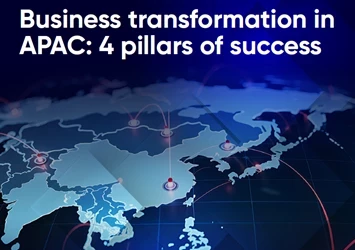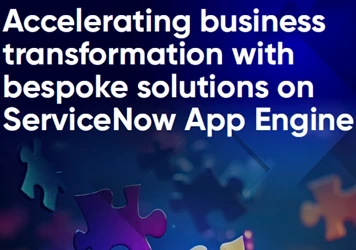The evolution of operational excellence in the APAC region
Nao Anthony, senior manager of operational excellence at Commonwealth Bank, discusses the trends, challenges and emerging solutions shaping operational excellence in the Asia-Pacific region in 2023
Add bookmark
Global events such as a slowing economies, supply-side disruptions, energy shortages and geopolitical unrest have had a profound effect on businesses in the Asia-Pacific (APAC) region. In its April 2023 report, the International Monetary Fund noted that while the region remains a “relative bright spot in an increasingly lethargic global economy”, economic growth was expected to remain subdued through 2023.

According to Nao Anthony, PEX Network Advisory Board member and senior manager of operational excellence at Commonwealth Bank (pictured right), operational excellence professionals play a pivotal role in guiding organizations through turbulent times such as these. To learn more about what this looks like in 2023, we asked him to share his thoughts on the emerging trends, challenges and solutions shaping operational excellence in the APAC region.
As he explains during the interview, operational excellence as a discipline is maturing and expanding to confront an ever-evolving array of business challenges. While lean and six sigma remain core methodologies, operational excellence leaders are embracing new, customer and product-centric ways of working such as Agile and customer journey mapping. Anthony also shares why, as organizations go about reinventing themselves for the digital age, operational excellence leaders will emerge as powerful voices of transformational change.
PEX Network: How has operational excellence evolved over the past decade in the APAC region?
Noa Anthony: The focus on continuous improvement (CI) culture and how it impacts customer value has increased, especially at the senior executive level. Organizations are taking the steps necessary to simplify the bottom-up approach to continuous improvement by deploying classic DMAIC (Define-Measure-Analyse-Improve-Control), PDCA (Plan-Do-Check-Act) and JDI (Just Do It) methodologies.
One of the benefits of this approach is that it equips employees with the tools necessary to autonomously problem-solve and, should a problem arise, escalate challenges as they occur. This represents a huge leap forward in our ability to keep up with rapidly-evolving customer needs and expectations.
Secondly, organizations are rethinking how they prioritize digital business initiatives and automation projects. Digital transformation initiatives are increasingly focused on deploying technology such as robotic process automation (RPA), optical character recognition (OCR), work flow tools, application programming interface (API) and low and no-code automation across the business value chain.
Last but not least, a decade ago, lean and six sigma were the go-to methodologies for achieving operational excellence and reaping its benefits. These days, the definition of operational excellence has broadened to include agile (scaled-agile) methodologies, customer-centric design, change management and project management as well as certain digital transformation and business strategy frameworks. As operational excellence leaders with skillsets in these areas are more likely to successfully navigate the current environment, the demand for them in the APAC region has skyrocketed.
PEX Network: How has lean evolved over the past decade? How do you foresee it evolving over the next 10 years?
NA: The classic lean deployments practiced in the manufacturing industry, equipped with an Agile outcome delivery mechanism, are making a comeback in response to the immense cost pressures organizations are facing. Organizations in the APAC region, where cost footprints are already more constrained, are disproportionally impacted by these economic pressures, especially in the shared service or value-added service provider sector.
Service and transactional organizations are moving towards multi-skilled, cross-functional cellular team structure to serve customer demands from a transformation perspective. As companies are looking to increase the speed of decision making, I expect there to be a comeback of classic work-cell concepts and standard work practices.
Voice-of-the-Customer and customer-needs analysis have matured into a cognitive behavioural approach to customer journey mapping. I find these techniques to be very powerful in helping us to understand and rapidly respond to customer needs. In addition, when used to simplify the customer onboarding experience, I have seen these tools generate substantial ROI.
PEX Network: How has six sigma in the APAC region evolved over the past decade and how do you see it continuing to evolve over the next 10 years?
NA: The conventional DMAIC based six sigma problem solving methodology has been handed over to full-time resources who are actively engaged in problem solving. I am increasingly seeing organization split traditional DMAIC methods into two parts: PDCA (simpler and less statistical path) and JDIs (just implement a change that is a known solution). This approach increases the speed at which solutions are delivered, enhances the customer experience from day one and is generally better suited for less mature continuous improvement cultures.
Based on my observations of other organizations and the case studies I have read from the logistics, financial and public sectors, there seems to be comparatively less emphasis on using statistical inference such as hypothesis testing to verify root cause analysis. This is due to two aspects.
- Changes in processes, and therefore factors impacting problems, post digital transformation do not need statistical hypothesis testing as the impact on factors are clear.
- Increased automation is eliminating subjectivity and introducing models and algorithms to the processes. In the interest of time, leaders proceed without statistical factor identification.
In the second case, I believe this oversight will have a negative impact in the long-term, especially if the root causes are misinterpreted and suboptimal solutions are deployed as a result. Due to the rapid rate of Agile solution development, the customers will experience non-conformance, which could result in complaints, escalations and even a decrease in Net Promoter Score (NPS).
PEX Network: Companies in the APAC region are investing heavily in digital transformation and will continue to do so for the foreseeable future. How will this impact operational excellence leaders?
NA: Digital transformation can be a double-edged sword. Organizations run the risk of setting a process in stone only to demolish it down the line when the customer demands something different, often at a great expense.
The first step in avoiding this starts at the very beginning when one is deciding which elements, functions, features and processes should be digitized. When overlaid with organizational capabilities, lean business management and strategic management tools and techniques serve as a true north guide towards digital transformation success.
Senior leaders can be tempted to approach digital transformation or in/outsource capabilities as merely cost-saving solutions. Such an approach can be detrimental to customers because it does not take end-to-end processes into account and, in turn, disrupts the value chain. This is where operational excellence leaders play a pivotal role. It is up to them to align the end-to-end value chain, customer journey, competitive value and existing capabilities with the larger goals of the organization.
Secondly, product and service design lifecycles have changed over the past decade. Considering that new technology and services are frequently disrupted or deemed obsolete in under two years, digital transformation needs to be agile and responsive to rapidly changing business models.
When it comes to calculating ROI of digital transformation from a product and service value chain (end-to-end) perspective, organizations are increasingly choosing the portfolio funding model over conventional business cases and the isolated project approach. Though calculating ROI is still under the purview of solution owners, operational excellence leaders can build their own end-to-end product value chain business cases using agile operating model structures.
The ROI of digital transformations that are intended to increase process efficiency are typically measured via FTE reduction. Similarly, the metric most frequently used to measure a digital transformation’s impact on revenue is relevant cost vs. revenue elements. To protect against cost bleeding[M2], it is important to also leverage calculations that factor in the full end-to-end service or product value chain including any pre- or post-sales activities. It is up to operational excellence leaders to guide the rest of the business on how to effectively make these calculations.
Thirdly, I am starting to see organizations put lean into practice by understanding the concept of value and removing value chain waste.
Operational experts that practice lean will not just automate a process as is, they take extra steps to understand the value of each component of the process. If a certain step or element within the end-to-end process does not add value to the customer, it will be removed. Furthermore, rather than simply looking at cost-savings, operational excellence leaders can help the business quantify the value of improved customer experiences.
In the short-term future, operational excellence leaders will become a prominent voice in shaping the enterprise change agenda and the skills they bring to the table – such as lean process improvement, strategy, digital, change, agile delivery and project management – will be increasingly in demand.
PEX Network: At the end of 2022, you wrote a three-part series of articles for us on “Seven elements to focus on as the end of the financial year approaches” where you presented a new, seven-part business operating model. Do you have any updates for us?
NA: In the series of articles, I outlined the end-to-end value chain approach to end of financial year (EOFY) analysis and discussed the importance of leading transformation from a product value chain point of view. These two strategies have proven effective in introducing Agile ways of working into core business functions and, as a result, have been embraced by the financial services industry.
On major element of success was that, using a bottom-up method, we embedded continuous improvement principles into the heart of the organization. In one of the articles I wrote, I mentioned that continuous improvement is the foundation for achieving basic value chain improvements. Given the significant cost pressures organizations are facing, coupled with rapidly changing customer demands, digital transformations should be focused on high value and impact processes that, once digitized, will significantly transform the customer experience.
In addition, transformational leadership, as a concept, has exponentially evolved over time. Many organizations are creating new roles such as ‘product owner’, ‘lean coach’, ‘Agility leader’ and ‘cell/ cross functional leaders’ to eliminate conventional, legacy bureaucratical structures. These roles demand a wide range of skills and enterprises are investing in upskilling employees to embrace these new ways of working.
In terms of next steps, I believe there is more work to be done defining value as it cascades throughout the value chain and linking it to enterprise measurement systems.
To clarify, once value is defined, the next logical step is to define the measurement system. As I argue in the third article, it is important for organizations to transition from lagging result measurements to leading root-cause drivers as the former can inadvertently drive negative behaviors.
In addition, I recommend only measuring what you can control or have influence over. Though these two principles are foundational to the manufacturing industry, they have yet to be fully implemented in the services sector.
In truth, my article was an overview of how leaders can avoid the last minute, knee-jerk and tactical solutions during EOFY period. By laying the groundwork for defining cost structure, these practices will deliver business value. There are, however, additional benefits to be had by achieving value chain alignment such as optimized operational outcomes, improved cross-functional collaboration and transformed customer experiences.
























